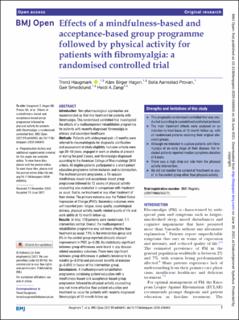| dc.description.abstract | Introduction: Non-pharmacological approaches are recommended as first-line treatment for patients with fibromyalgia. This randomised controlled trial investigated the effects of a multicomponent rehabilitation programme for patients with recently diagnosed fibromyalgia in primary and secondary healthcare.
Methods: Patients with widespread pain ≥3 months were referred to rheumatologists for diagnostic clarification and assessment of study eligibility. Inclusion criteria were age 20–50 years, engaged in work or studies at present or during the past 2 years, and fibromyalgia diagnosed according to the American College of Rheumatology 2010 criteria. All eligible patients participated in a short patient education programme before inclusion and randomisation. The multicomponent programme, a 10-session mindfulness-based and acceptance-based group programme followed by 12 weeks of physical activity counselling was evaluated in comparison with treatment as usual, that is, no treatment or any other treatment of their choice. The primary outcome was the Patient Global Impression of Change (PGIC). Secondary outcomes were self-reported pain, fatigue, sleep quality, psychological distress, physical activity, health-related quality of life and work ability at 12-month follow-up.
Results: In total, 170 patients were randomised, 1:1, intervention:control. Overall, the multicomponent rehabilitation programme was not more effective than treatment as usual; 13% in the intervention group and 8% in the control group reported clinically relevant improvement in PGIC (p=0.28). No statistically significant between-group differences were found in any diseaserelated secondary outcomes. There were significant between-group differences in patient’s tendency to be mindful (p=0.016) and perceived benefits of exercise (p=0.033) in favour of the intervention group.
Conclusions: A multicomponent rehabilitation programme combining patient education with a mindfulness-based and acceptance-based group programme followed by physical activity counselling was not more effective than patient education and treatment as usual for patients with recently diagnosed fibromyalgia at 12-month follow-up | en_US |
